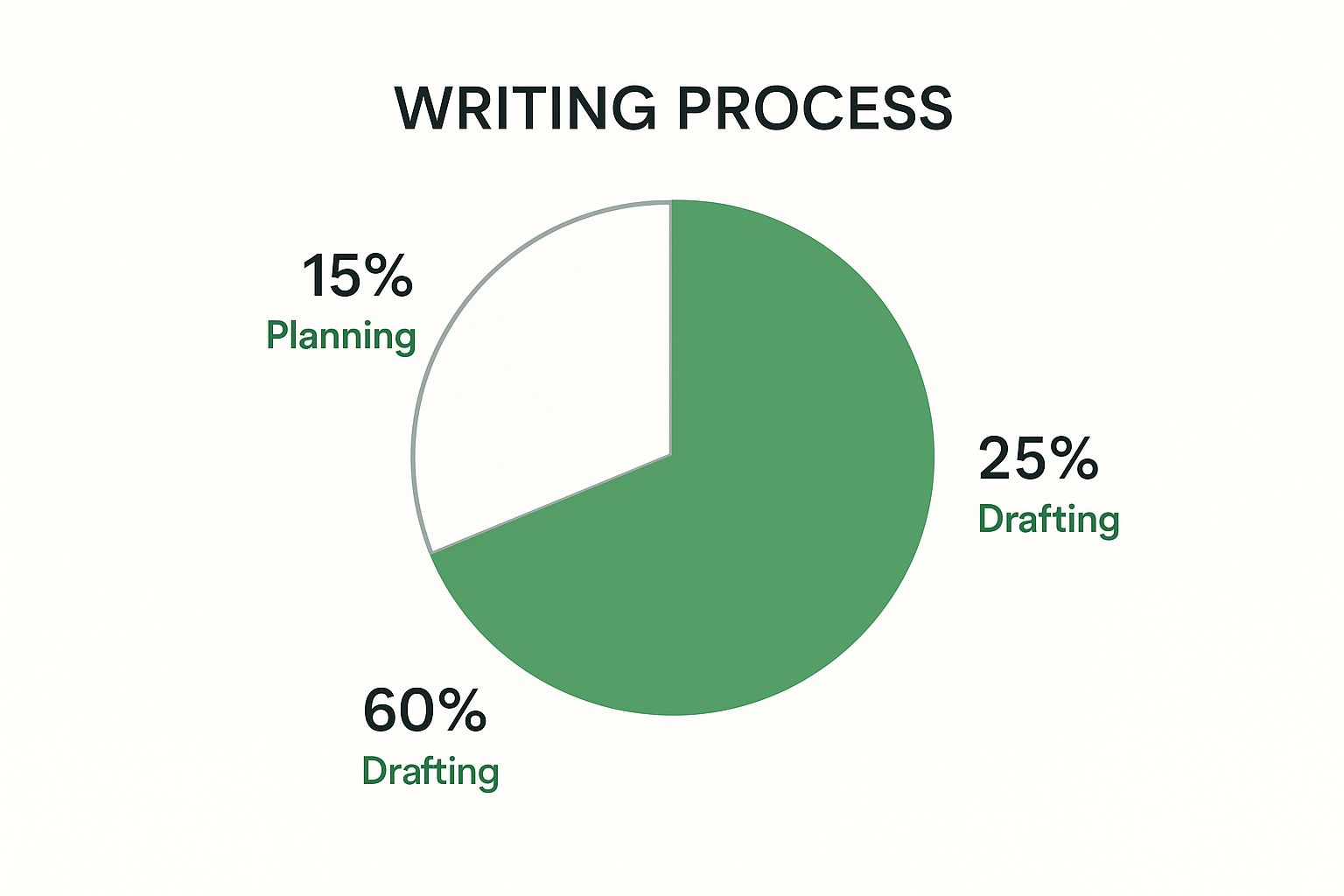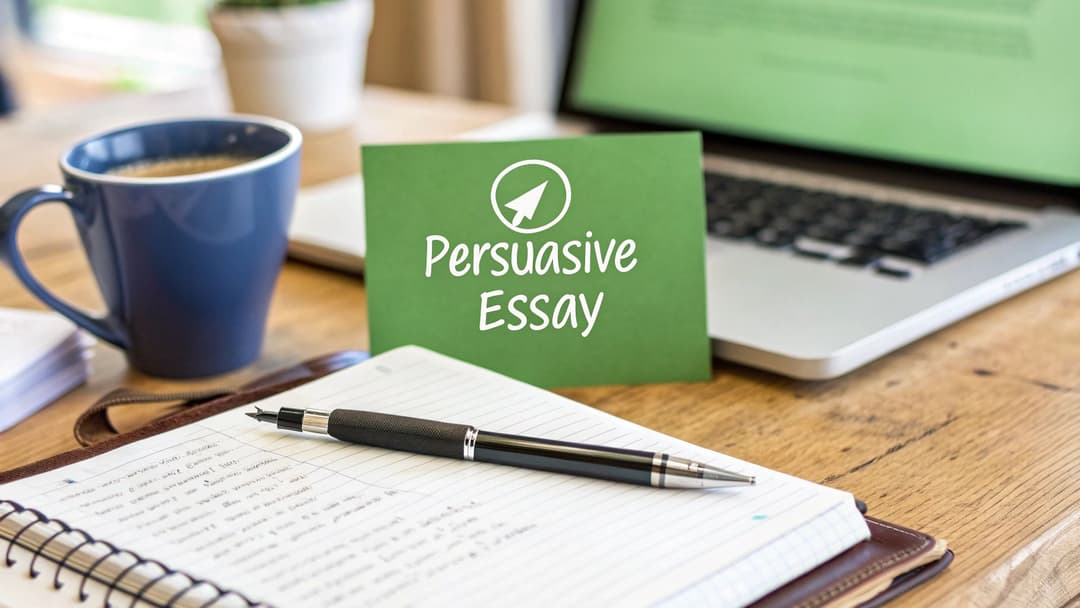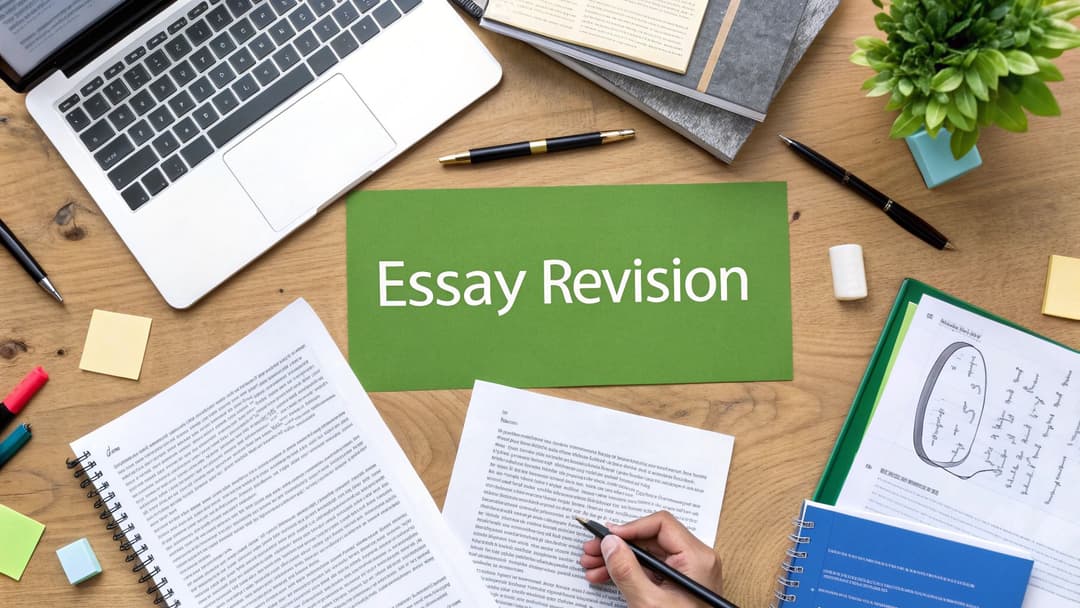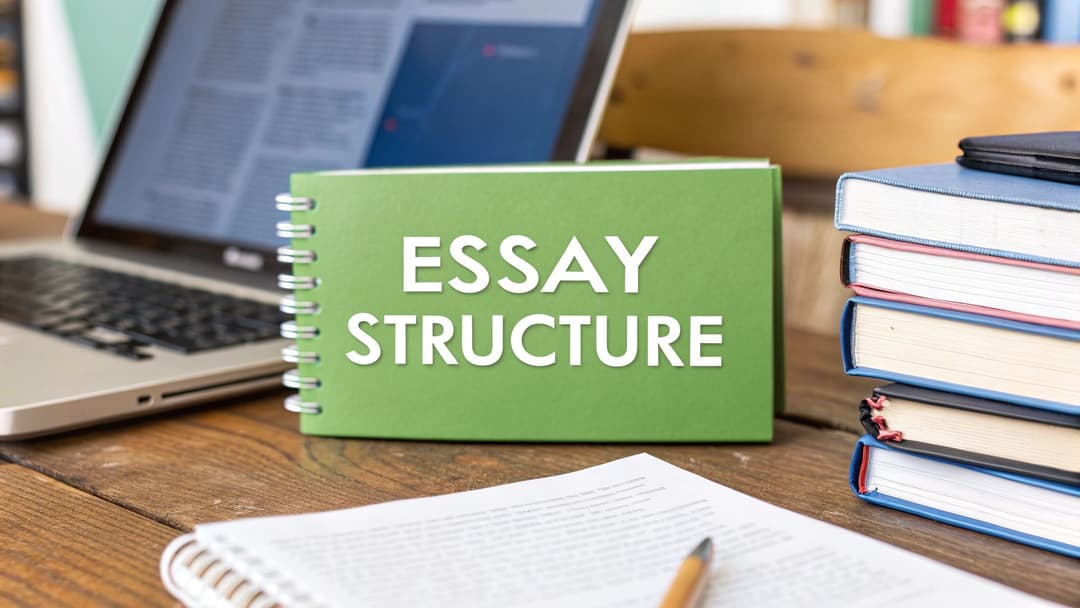
Learn How to Write More Efficiently in Simple Steps
June 22, 2025
Finding Your Perfect Writing Environment
Figuring out how to write more efficiently often starts long before you type a single word. It begins with your surroundings. Many of us get hung up on finding the "perfect" setup, but the truth is, a productive environment is deeply personal. It's less about a specific desk or fancy chair and more about understanding what signals your brain to enter a state of deep focus. For some, it's the gentle hum of a coffee shop; for others, it's absolute silence with noise-canceling headphones.
This isn't just a feeling. Recent productivity stats show a compelling trend: a 33% global increase in desk bookings year-over-year suggests people are actively seeking dedicated spaces to improve concentration. With 34% of businesses now planning for flexible work models, writers have more freedom than ever to design a schedule that carves out time for intense, uninterrupted writing.
Identifying Your Personal Productivity Triggers
The key is to experiment and figure out what actually works for you. Think of yourself as a scientist observing an experiment. For one week, try writing in different locations at different times. Pay attention to how you feel and, more importantly, how many words you manage to get down.
Here are a few things to track:
- Location: Do you thrive on the background energy of a bustling library, or do you need the sterile quiet of a dedicated home office?
- Sound: Does instrumental music help you focus, or is silence golden? Apps like MyNoise offer customizable soundscapes that can be a game-changer for blocking out distracting sounds.
- Lighting: Natural light is often praised as a mood and productivity booster. If you're stuck in a dim corner, think about getting a daylight-replicating lamp to reduce eye strain and keep your energy up.
The goal is to discover your unique combination of environmental cues that tell your brain, "Okay, it's time to write." Once you establish this, it becomes a powerful mental shortcut that reduces the friction of getting started.
To illustrate how different setups can affect output, I've put together a quick comparison based on common writing environments.
Writing Environment Optimization Comparison
This table compares different workspace setups and their typical impact on writing efficiency metrics.
| Environment Type | Focus Duration | Words Per Hour | Distraction Level |
|---|---|---|---|
| Quiet Home Office | 60-90 mins | 800-1,000 | Low |
| Busy Coffee Shop | 25-45 mins | 500-700 | High |
| Co-working Space | 50-75 mins | 700-900 | Medium |
| Library (Silent Zone) | 75-100 mins | 900-1,200 | Very Low |
As you can see, a silent library might yield the highest word count, but the structured environment of a home office offers a great balance. The key takeaway is that an environment with minimal distractions consistently leads to better focus and higher output.
For instance, this image shows a modern workspace designed for flexibility.
What's interesting here is the blend of personal and professional elements—multiple monitors for an optimized workflow, but positioned in a very open setting. This highlights a common challenge: creating your own personal focus bubble within a potentially distracting larger environment.
Creating Rituals to Prime Your Brain
Once you know your ideal setup, the next step is building a pre-writing ritual. This isn’t about procrastinating; it's a deliberate warm-up for your mind. It could be as simple as making a specific type of tea, putting on your "focus" playlist, or doing a quick five-minute brain dump in a notebook.
This ritual becomes a strong psychological cue. It signals a clear transition from everyday tasks to focused, creative work, making your writing sessions far more effective right from the start.
Using AI Writing Tools While Keeping Your Voice
 Artificial intelligence is no longer some far-off idea; it’s a real tool sitting on our desktops. The big question isn't if you should use AI to write faster, but how to do it without your writing sounding like a robot. The trick is to stop letting AI write for you and start making it write with you. Think of it as a super-fast research assistant or a brainstorming partner that never gets tired.
Artificial intelligence is no longer some far-off idea; it’s a real tool sitting on our desktops. The big question isn't if you should use AI to write faster, but how to do it without your writing sounding like a robot. The trick is to stop letting AI write for you and start making it write with you. Think of it as a super-fast research assistant or a brainstorming partner that never gets tired.
The use of AI writing assistants has exploded, changing what it means to be efficient. Since 2023, the market for these tools has been growing at a rate of 36.6% each year. This isn't just about getting things done quicker; companies are reporting a 66% boost in productivity and are publishing content 40% faster. This shift shows just how important it is to fit AI into your work in a smart way. You can explore the AI writing statistics to see the full picture for yourself.
From Prompt to Polish: An AI-Assisted Workflow
The real magic is in how you direct the AI. Simply asking a tool like ChatGPT to "write a blog post about efficient writing" will probably get you a generic, lifeless article. Your personal stories, tone, and insights are what make your content special. The AI is just there to do the heavy lifting.
Here’s a better way to approach it:
- Brainstorming and Outlining: Start with your core idea and ask the AI for a few different outlines. You could say, "Give me an outline for an article about efficient writing for freelancers, focusing on time-blocking and batching tasks. Make sure to include a part on avoiding burnout."
- Drafting Section by Section: Pick one section from the outline you like best and ask the AI to write a first draft. Give it specific details, tell it the tone you want (like "conversational and encouraging"), and mention any key points you need to hit. This is where you start to put your own spin on it.
- Refining and Humanizing: This step is the most important. The AI’s draft is just your raw material. Now, you take over as the editor. Rework sentences to sound more like you. Add personal anecdotes, specific examples from your own work, and a bit of emotion. This is where a platform like our own Natural Write can be a huge help, smoothing out robotic phrases and making sure the final piece sounds completely human.
When you treat AI as a partner instead of a replacement, you stay in control of the creative process. You get all the speed and efficiency without giving up the authentic voice that connects with your readers. This is how you write more efficiently today—by mixing human creativity with the power of machine assistance.
Creating a Writing Workflow That Fits Your Style
Generic productivity advice often falls flat because it ignores a simple truth: every writer is different. The key to writing more efficiently isn’t about finding a single magic formula, but about building a repeatable system—a writing workflow—that aligns with your personal rhythm and project demands. This structured approach isn't meant to be rigid; it’s a framework that frees up mental energy by automating the process of writing, so you can focus entirely on the content.
High-output writers don't just sit down and hope for the best. They have distinct phases for their work, usually broken down into planning, drafting, and editing.
This infographic shows a typical time allocation for a writing project.

As you can see, the bulk of the time is spent drafting, but the dedicated planning and editing phases are what make that drafting time smooth and effective.
Designing Your Core Workflow Stages
A great workflow separates different types of tasks, a technique known as task batching. Instead of jumping between researching, writing, and editing a single paragraph, you dedicate focused blocks of time to each stage across the entire project. This prevents context-switching, which is a major drain on your focus and energy.
A popular method is the three-stage workflow:
- Research & Outline: In this stage, your only job is to gather information and structure your ideas. Don't worry about writing full sentences yet. Just collect links, stats, and quotes, and arrange them into a logical skeleton.
- Drafting (The "Ugly First Draft"): Here, you write without stopping to edit. The goal is momentum. Follow your outline and get the words on the page, even if they're clumsy. You can find more effective writing strategies on our blog to help speed up this phase.
- Editing & Polishing: After taking a break, you return with fresh eyes to revise. This is a separate process dedicated to improving clarity, flow, and correcting errors.
To get a better sense of which approach might fit your needs, this table compares different workflow methods.
| Workflow Type | Best For | Time Investment | Quality Output | Difficulty Level |
|---|---|---|---|---|
| Three-Stage Workflow | Blog posts, articles, reports | Medium-High | High | Medium |
| Freewriting / Brain Dump | Creative ideas, overcoming writer's block | Low | Variable | Easy |
| Pomodoro Technique | Short, focused writing tasks | High (in short bursts) | Good | Easy |
| Iterative / Agile Writing | Long-form projects (books, theses) | High | Very High | Hard |
The key takeaway is that more structured workflows, like the three-stage method, tend to produce higher quality work but require more discipline to implement.
You can manage this entire process within a single project management tool. Tools like Notion allow you to create a custom dashboard where you can house your research notes, outlines, and drafts all in one place, which helps with the handoff between stages.
Interestingly, while individual workflows are key, the corporate world is also grappling with efficiency. By 2025, while most companies have invested in AI to boost productivity, a study reveals only 1% feel they have truly mastered its use. This highlights a huge opportunity for writers who can build workflows that properly integrate these powerful tools. You can read more about these insights on AI's potential at work to see how you can get ahead. Creating a personal system is the first step toward that mastery.
Writing Faster Without Losing Quality
Ever feel like you’re stuck choosing between writing quickly and writing well? It’s a common frustration, but speed and quality don't have to be enemies. The secret is to stop trying to do two things at once: drafting and editing. When you obsess over perfecting each sentence as you go, you’re constantly hitting the brakes on your creative flow. A much better way, borrowed from journalists and other writers on tight deadlines, is to get a complete first draft down on paper before you even think about polishing it.
One of the best ways to put this into practice is with focused writing sprints. Set a timer for a short, manageable burst—maybe 25 or 30 minutes—and just write. Don't stop. Ignore the typos, the clunky phrases, and that nagging feeling that there's a better word out there. Your only job is to get your thoughts out of your head and onto the page. This simple exercise trains your brain to keep the creative, idea-generating part separate from the critical, analytical part.
Aligning Typing Speed with Thinking Speed
Another piece of the puzzle that often gets ignored is the physical act of writing itself. If your fingers can’t keep pace with your thoughts, you create a bottleneck that can shatter your concentration. You don't need to be a world-class typist, but improving your words per minute (WPM) can make a real difference. The average typing speed is about 40 WPM, but many professional writers aim for 70 WPM or higher to make sure their hands can move as fast as their ideas are flowing.
If you’re curious about where you stand, a quick online test can give you a baseline.

This screenshot shows a typical typing test that measures both your speed and accuracy. Even a small, consistent effort to type faster can remove a surprising amount of friction from your writing process, making your drafting sessions feel much smoother.
Smart Word Choices and Fluency
Finally, having a solid vocabulary and a good grasp of sentence structure is foundational to writing both quickly and clearly. When you have a rich bank of words to pull from, you spend less time hunting for the right one. This isn't about dropping fancy, complicated words into your sentences; it's about having the perfect word ready when you need it. A great way to build this skill naturally is to read widely across different genres. If you're looking for more structured advice, our post on how to improve writing skills offers some practical exercises.
By combining these three elements—focused drafting, faster typing, and a confident command of language—you can create a system where speed and quality finally start working together.
Smart Research and Planning Strategies
The most productive writers know a little secret: the real work of writing happens long before you type the first word. Spending time on smart research and solid planning isn't just busywork—it's an investment. It drastically cuts down your drafting time and saves you from agonizing over heavy revisions later. A well-planned article almost writes itself, turning a blank page from a source of dread into a simple connect-the-dots game.
The point of early research isn't to become the world's top expert on a topic. It's about gathering just enough information to write with confidence and authority. Too many writers get lost in the "research rabbit hole," spending hours collecting facts they'll never actually use. That’s where a good plan makes all the difference.
The "So What?" Test for Focused Planning
Before you even think about opening a new browser tab, take a moment to clarify your article's purpose. A great way to do this is with the "Goal - So What?" test, a simple exercise inspired by marketing expert Ann Handley. Start by stating your goal. For instance: "The goal of this post is to teach readers how to plan their writing." Then, keep asking, "So what?"
- So what? They'll save time when they sit down to write the draft.
- So what? Saving time reduces frustration and helps prevent writer's block.
- So what? This makes writing a more enjoyable and sustainable practice, which helps them create better content more consistently.
This quick exercise forces you to zero in on the reader's benefit. It gives you a clear, compelling angle that acts as a filter for your research, helping you instantly decide which information is essential and which is just noise.
Organizing Your Findings for Faster Drafting
Once your research is done, how you organize it is everything. Instead of saving a messy list of links, create a structured outline and plug your findings directly into the relevant sections. This approach turns your research from a passive pile of data into an active part of your writing workflow. Your tool for this can be a simple word document or a dedicated note-taking app.
For example, a tool like Evernote lets you clip articles, jot down notes, and sort your research into specific notebooks.
Using a system like this helps you build a library of organized ideas that you can easily pull from when it's time to start writing. By preparing your materials this way, you've already done much of the heavy lifting. The actual process of putting sentences together becomes far more efficient and much less intimidating.
Editing Strategies That Save Time and Improve Impact

Many writers believe that efficient writing ends once the first draft is done. But the editing phase is where you can either claw back hours of your day or fall into a frustrating cycle of endless tweaks. The secret isn't just to edit, but to edit with a system. Trying to fix grammar, flow, and structure all at once is a recipe for burnout.
A much smarter approach is multi-pass editing. This means you review your draft several times, but each pass has a single, clear goal. It turns a chaotic chore into a focused process. Your first review might focus only on the big picture: Does my argument hold up? Is the structure logical? You’re not chasing commas; you’re shifting entire paragraphs. Later passes can zoom in on sentence-level fixes like clarity, style, and finally, a proofread for typos.
Leveraging Tools for an Objective Eye
It’s incredibly hard to edit your own work. You already know what you meant to say, which makes it easy to skim over awkward phrasing or confusing sentences. This is where modern tools become such valuable partners. They offer an objective perspective that’s almost impossible to find on your own.
Platforms like Grammarly or the Hemingway App can instantly flag clumsy sentences, passive voice, and complex wording that might weaken your message. Think of them as your first line of defense, handling the technical cleanup so you can stay focused on the creative side of things. The screenshot above shows how these tools go beyond spell-checking to give you real feedback on how a reader will experience your text, which is key for writing content that connects.
Knowing When to Stop
Maybe the toughest part of editing is deciding when a piece is "done." The hunt for perfection is a notorious time-waster. A good rule to live by is to prioritize impact over perfection. Before making a change, ask yourself: does this edit meaningfully improve the reader's understanding or engagement? If the answer is a shrug, it’s probably time to move on.
Developing this kind of editorial judgment is vital for writing efficiently. After a few focused editing passes, learn to trust that your work is solid. True efficiency isn’t just about writing faster—it’s about confidently hitting "publish" without getting bogged down in minor revisions. If you'd like to explore this further, our guide on how to write compelling content offers more tips on making your words resonate.
Putting It All Together for Efficient Writing
Turning all these ideas into a system that works for you is the final, and most critical, part of the process. Efficient writing isn't about following a rigid checklist; it's about building a workflow that fits your creative style and goals. This section pulls together the most important strategies from this guide into advice you can use right away.
Build Your Personalized Efficiency Plan
First, take an honest look at your current writing habits. Where do you lose the most time? Do you fall down research rabbit holes, or does editing feel like it takes forever? Once you know your main bottleneck, you can pick the right techniques to fix it.
- If you're an over-researcher: Try the "So What?" test before you even start writing. This simple question forces you to focus your research on information that actually matters to your piece, preventing you from gathering details you'll never use.
- If you're a perfectionist drafter: Commit to focused writing sprints. The goal here is just to get words on the page and build momentum. Don't worry about perfection. You have to completely separate the act of drafting from the act of editing.
- If you're an inconsistent editor: Create a multi-pass editing system. Your first pass should be for structure and flow. The second pass is for clarity and word choice. The final pass is for proofreading and catching small errors.
Track Your Progress and Stay Flexible
Building new habits takes time, so don't expect to double your writing speed overnight. Instead, look for small, consistent improvements. Is your first draft taking 10% less time than it used to? Are your editing passes becoming more targeted? These are the real signs of success.
A big warning sign that something isn't working is if you feel constantly frustrated or burned out. If a technique feels like a persistent struggle, it might not be a good fit for you. The whole point is to find methods that reduce friction, not create more of it.
Finally, remember that your writing needs will shift over time. A workflow that’s perfect for short blog posts might not work for a long-form research paper. Be ready to adapt your system as your projects change. Real efficiency is a skill that grows with you. By combining smart strategies with helpful tools, like using Natural Write to humanize and polish your AI-assisted drafts, you create a lasting practice that makes writing faster, easier, and even more enjoyable.


